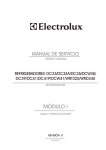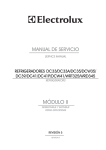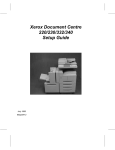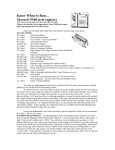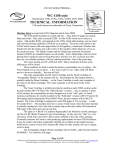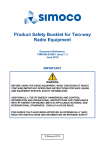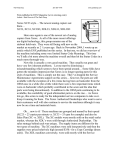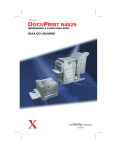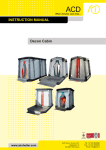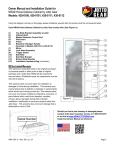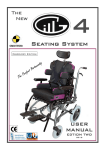Download CHOE RESIDENCE - PLANT LIST
Transcript
Fixing the Fusers…Xerox DC220 style, DC332 style & N24 style (Document Centre) DC220, DC230, DC420, DC426… also DC332, DC340, DC425, DC432, DC440, Docuuprint N24, N32, N40, N3225, N4025 & N4525 If you’ve been following recent ENX articles, you’ve seen we’ve repeatedly turned the floodlight of our attention to the fuser modules and how to fix them. Here is a series of machines which is definitely plentiful enough to be worth learning about. The Xerox Document Centre 220/230/420/426 and also the DC 332/340/425/432/440 are copiers which are basically Printers with a separate scanning section suspended above the printer engine. The straight printers in this series include the N24/32/40, N3225/4025 and the N4525. These machines are plentiful and the fusers are moving rather well out there. They are not terribly difficult to disassemble and just about all of the parts are available… so unless you are super busy and don’t have time to do this sort of work, it pays to take home the used fuser and fix it in the comfort of your own workbench for the next customer who calls needing one. First we’ll do a quick rundown of the 3 basic versions of the Fusers in this group including the part numbers which apply to them. Then we will dissect one of these things and see how they come apart. Afterward we’ll look at how to reset the Fuser Overheat Status Codes and the Maintenance Cycle. The fusers are offered in the OEM Parts Lists as Fuser Modules and they are also offered for some of the machines as part of the OEM “Maintenance Kits”. The OEM kits include an OEM reworked Fuser Module, 12 Feed Rolls (enough to do 4 trays) and a Bias Transfer Roller (BTR) Assembly. Here are some of the part numbers which pertain to the fusers which are covered in this article: DC220/230/420/426 Fuser Module: 126K6050 DC332/340/425/432/440 Fuser Module: 600K73193 N24/32/40, N3225/4025 Fuser Module: 126K10011, Maintenance Kit: 109R486 N4525: Maintenance Kit: 109R48 The 4 types of fusers above are different in some ways from one another although the procedure for disassembling them remains virtually the same for all of them. The easiest way to tell these apart is to look at the main AC Connector which interfaces with the one in the machine. The DC220 version is substantially different from all of the other versions. It has a white connector with 8 female contacts. The N24 version has a very different AC Connector (black with places for 8 pins) The N24 version is proving to be interchangeable with the DC332 machines. The newer N4525 model has a different AC Connector which is black and has places for 12 pins. Take a look at the photos below which show all 3 versions. DC220 version DC332 / N24 versions Each of these fusers have two Fuser Lamps… a Hi-Watt (Main) Heat Lamp and a Low-Watt (Sub) Heat Lamp. They are different for each of the 3 versions shown above (differences in wattages and also, the DC220 version has a different shape to the metal contact at one end (see photo of the ends of the two lamp types). Most of the parts for the N4525 appear to be identical to the N24 / DC332 version although obviously the AC Connector differences make it impossible to interchange the entire fuser module. Another difference is that the newer N4525 has an extra wire which goes to a static eliminator brush on the heat roll. The DC220 version of the fuser does not share common parts with the other fusers in spite of the design being very similar. The Heat and Pressure Rollers of the DC220 fuser are considerably smaller in diameter compared to the others. Even the Heat Roll Stripper Fingers will not interchange (the DC220 has a taller profile so it won’t fit into the holder bracket of the other versions). N4525 version Lamp differences Roller differences (left = DC332 / N24…right = DC220) First lets get oriented (see the Orientation photo). I’ll be referring to the “Rear” and “Front” ends. The Heat Roll Drive Gear is at the rear end. Then there is the “top” and “Bottom” as the fuser would sit in the machine. The “Outer-face” is the part which is visible when you open the left door of the machine to access the fuser. We will use the DC332 / N24 version as the Guinea Pig and model for the disassembly part of this article. Where appropriate I’ll include a note about how the DC220 or N4525 procedure might differ. Orientation Procedure: 1.) Remove the Pressure Roll Cover Assembly. It is relatively fragile, so removing it early in the process is a good idea. It is held on by 3 screws (self tapping). 2.) Remove the Front Outer-Facing Cover which has the green jam removal gear attached to it. (2 screws, 6mm machine thread). You can now lift out the front yellow plastic finger-pull (not present on the DC220 version). 3.) Release the two front Heat Lamp Contacts (they are screwed to the Front End Cover). Once the lamp contacts are freed up, it is safe to remove the Front End Cover (2 screws from the front, 10mm machine thread). Be gentle with the lamp-return contact which is now exposed and vulnerable. You can see how trying to yank the Front End Cover off before you release the lamps would be a mistake which would result in broken glass. Front End – Exposing the two Lamp Contacts. 4.) Now for the rear end. Start with the Rear Outer-Facing Cover with its front yellow plastic finger-pull (2 screws from the outer-face, short machine thread). This reveals a sphagetti of wires (see Photo). Then you can release the Rear End Cover and pivot it out of your way (2 screws from the rear end, 10mm machine thread) 5.) You’ll need to release the two wire leads for the fuser lamps in order to then slide them out through the opposite front end. I found it most convenient to put the lamp terminal screws right back in place resecuring the red and blue wires which go on to the AC Connector. Rear End - With the Outer-Facing Cover removed… 6.) Next remove the bar which is adjacent to the Pressure Roll (it has static eliminator brushes attached to it). Take note of how the 3-tined fork-like contact at the front end is seated against the bar. The bar can be released by simply backing out the screws a tiny bit (one from either end of the bar). Don’t take those screws off all of the way because the white plastic bushings which are on either end will fall off easily into several pieces. (This step doesn’t apply to the DC220 version which is missing this bar). 7.) Remove the Heat Roll Stripper Assembly (2 screws… 10mm self tapping). Clean off the magnets which are opposite of each finger (these serve to catch any toner flakes which the fingers scrape off of the heat roller). There are no such magnets on the DC220 version. To get the individual 5 fingers off of the assembly / bracket you must first remove a tiny screw at one end to take a metal plate off of the assembly. 8.) Check the height of the pressure screws at both front and rear and write down the measurements so that you can return the screws to the same height. There is a Fuser Nip Adjustment available for the DC220 which we’ll look at later on. Back out both of the Fuser Pressure Screws and place the screws, springs, and collets or washers aside in a safe place where they won’t disappear on you. 9.) Now if you lift the pressure arms, the Pressure Roll with its bearings can be removed. It is a sleeved roller. The Heat Roll is now also available to lift out of the assembly. You’ll want to release the green ground strap from the rear pressure arm to give you more room to open that rear arm wide. 10.) With the Heat Roll Assembly out, you can access the Thermistor and the two Thermostats. Note that the DC220 version has only one Thermostat. The N4525 has as second Thermistor located close to the front end of the fuser. 11.) Reassemble… Folks often ask which way the Thermistor and Thermostats flanges on the heat rolls are supposed to be positioned. The bearing flanges need to be positioned towards the end of the roller and must sit outside of the metal frame on both ends when you go to place it back in the fuser. The newer versions of the fusers have a rather clever way of releasing the tension on the pressure roller during storage and shipping. This is important because it doesn’t take terribly long for the pressure roll to develop a flat spot which will cause all kinds of clunking noises before it rounds out and recovers. They come with a metal cap which is twisted down over the Pressure screw to cam up the pressure arm. When someone goes to install the new fuser, it comes with instructions to turn each of these caps ½ turn counterclockwise to remove them, before using the Pressure Relief Cap for storage… fuser (if you were to forget and leave the caps in (Removed during installation of fuser) place, the fuser would have no pressure and the copies would come out unfused). Keep any of these caps you run across for future use. They are handy indeed. When you respond to a Fuser Related call, you’ll want to bring a new fuser (or one you rebuilt earlier), and little bit of information. First thing to do is to check out the fuser’s fuser lamp circuits and the thermistor circuit as well. It’ll be handy to know which pins are which on the fuser module so that you can diagnose the problem without needing to take the fuser apart. You’ll notice that the pin numbering is not consistent. This is because the pin-out in the Service Manual is not consistent. The DC220 numbers the pins top to bottom and the others number the pins from right to left. Lets “pin” these things out one “style” at a time… DC220 style Fuser Connector (PJ12) Pin-out: Pin 1: Thermistor (thin black wire) Pin 2: - Blank Pin 3: Hi-Watt Heat Lamp (red wire) Pin 4: Lo-Watt Heat Lamp (blue wire) Pin 5: Thermistor (thin black wire) Pin 6: Ground (green wire) Pin 7: - Blank Pin 8: Return from Heat Lamp & Thermostat Circuit (white wire) Testing the DC220 style Circuits: • Hi-Watt Lamp & Thermostat Circuit: Pins 3 & 8... should be between 4 & 12 Ohms (Ω). • Lo-Watt Lamp & Thermostat Circuit: Pins 4 & 8… should be between 4 & 12 Ohms (Ω). • Thermistor Circuit: Pins 1 & 5… should measure around 300K Ohms (Ω) when the fuser is cold and resistance should drop if the thermistor’s face is warmed up… drops to around 1.5K Ohms when at operating temperature. DC332 style & N24 style Fuser Connector (PJ12) Pin-out: Pin 1: Thermistor (yellow wire) Pin 2: Thermistor (yellow wire) Pin 3: - Blank Pin 4: Bias / Static Eliminator Brushes (brown wire) Pin 5: Lo-Watt Heat Lamp (blue wire) Pin 6: Hi-Watt Heat Lamp (red wire) Pin 7: Return from Heat Lamp & Thermostat Circuit (white wire) Pin 8: Ground (green wire) Testing the DC332 & N24 style Circuits: • Hi-Watt Lamp & Thermostats Circuit: Pins 6 & 7... should be between 4 & 12 Ohms (Ω). • Lo-Watt Lamp & Thermostats Circuit: Pins 5 & 7… should be between 4 & 12 Ohms (Ω). • Thermistor Circuit: Pins 1 & 2… should measure around 300K Ohms (Ω) when the fuser is cold and resistance should drop if the thermistor’s face is warmed up… drops to around 1.5K Ohms (Ω) when at operating temperature. N4525 Fuser Connector (PJ12) Pin-out: Pin 1: Rear Thermistor (yellow wire) Pin 2: Rear Thermistor (yellow wire) Pin 3: Return from Heat Lamp & Thermostat Circuit (white wire) Pin 4: Front Thermistor (black wire) Pin 5: Front Thermistor (black wire) Pin 6: - Blank Pin 7: Lo-Watt Heat Lamp (blue wire) Pin 8: - Blank Pin 9: Hi-Watt Heat Lamp (red wire) Pin 10: Ground (green wire) Pin 11: - Blank Pin 12: Bias / Static Eliminator Brushes (brown wire) Testing the N4525 Circuits: • Hi-Watt Lamp & Thermostats Circuit: Pins 9 & 3 ... should be between 4 and 12 Ohms (Ω). • Lo-Watt Lamp & Thermostats Circuit: Pins 7 & 3… should be between 4 and 12 Ohms (Ω). • Front Thermistor Circuit: Pins 4 & 5… • Rear Thermistor Circuit: Pins 1 & 2… Both Thermistor circuits should measure a high (but not infinite) resistance on the 1000 Ohms (Ω) scale and should drop as the face of the thermistor is warmed up. You’ll also want a quick run-down of how to approach each possible fuser related Status Code. Sometimes these machines are reluctant to display a Status Code at all. Pressing the “Machine Status” button (DC220 and DC332 styles only) will usually give you an opportunity to view the “Fault History”… the top code is the most current Status Code. Some of the codes need to be reset from the diagnostics before the machine will attempt to warm up again. U4-1 Status Code means “Fuser Under-temperature” (you’ll be looking for a bad heat lamp or blown thermostat). The U4-1 does not require a reset from diagnostics. U4-2 Status Code means “Fuser Over-temperature”. This code you’ll want to approach with extra caution. You need to figure out why the fuser got too hot, otherwise you’ll pop a new fuser in and have it ruined by the same initial problem which caused the overheat. It could be that the Fuser Cooling Fan is not doing its job properly (make sure it turns freely in operation and that any filter which may be present isn’t clogged… also make sure the machine has adequate space around it to breathe). Its also possible that a short in the wiring or on the Driver Board is causing one or both heat lamps to stay on continuously… so, once you reset the U4-2 code from diagnostics, you’ll want to watch the fuser to see if the lamps come on, and more importantly you’ll want to make sure that once they’ve reached the ready state, they cycle on and off like they’re supposed to. Once you’re ready to watch the lamps carefully and you’ve repaired the problem which caused the U4-2 code, you can reset it from the Diagnostics as follows: Enter Diagnostic Mode (press “Access” on the panel, then enter the default password ‘#’, ’1’, ’1’ followed by ‘Enter’). Then touch “dC Routines” and then “dC131”. Scroll through the list to “50-20 Fuser Over temp Reset”. Press ‘Read’ and then change the value from ‘1’ to ‘0’ and press ‘confirm’ to lock in your selection. When you turn the power off and back on, the machine will attempt to warm up again… watch those lamps to make sure they cycle out when the fuser is fully heated. U4-3 Status Code means “Fuser Thermistor Failure”. This code comes up if the machine detects an Open Circuit across the Thermistor Circuit. Make sure the fuser is fully seated and that the fuser connector is making good contact with the connector in the machine. Check the thermistor circuit using the 1000 Ohms scale as detailed earlier. This code does not require resetting from diagnostics. Maintenance Light (N24 style and N4525 only): The N24 style and the N4525 will call for a “Maintenance Kit” after 300K prints. You will need to reset the Maintenance Counter from the Diagnostics before the machine will operate again. Resetting the Maintenance Kit Counter: Hold down the [2]<Item Up> And the [5]<Item Down> buttons at the same time while turning on the Printer. Continue holding those two keys until the message “IOT?” shows up. Then, within 5 seconds after the “IOT?” message appears, hold down the [0]<On Line> and [5]<Menu Down> keys at the same time until it says “Reset Complete Please Reboot”. Then turn the power off and back on. That should give you all you need to approach these fusers with confidence. Nothing like a little bit of familiarity with a fuser before you begin ey? Happy Repairs! Britt works for The Parts Drop, a company whose primary business is providing parts, supplies and information for Xerox brand copiers, printers and fax machines. You can find more information on their website www.partsdrop.com. There’s a complete listing of past articles under contributing writers on the ENX website (www.ENXMAG.com) if you’d like to read more about Xerox brand office equipment.








